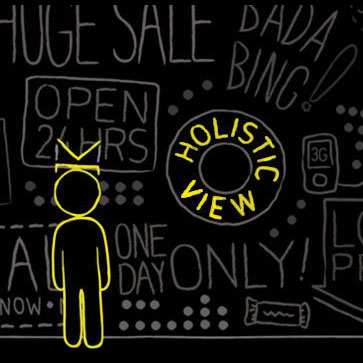Crash Course on Mobile Advertising Formats, Trends & Projections

Can you believe it?
It hasn't even been 10 years since we got the first iPhone.
And yet in the last 12 months we spent more time consuming content on mobile devices than watching TV, for instance. And according to comScore, last year U.S. users spent 7 out of 8 minutes of media consumption on mobile devices.
It comes as no surprise then that mobile marketing grows at the fastest pace among digital advertising formats today.
And there is a lot of data to prove it.
According to BI Intelligence for instance, U.S. mobile ad spend will top nearly $42 billion in 2018. Statista predicts that worldwide spend on mobile advertising will reach $59.67 billion in 2017.
As Atul Satija, VP of InMobi, a mobile advertising platform says:
"Advertisers and ad tech companies are convinced that mobile will be, if not already is, the dominant platform for consumer engagement."
So what are the general forecast and best practices for the mobile advertising industry?
Mobile Advertising Adoption Rate
Up until recently there has been a major disparity between the adoption of mobile devices and the amount of money spent to advertise on them.
One reason for that may have been a poor cross-device attribution model and higher conversions on desktops.
Commentators have also claimed that the disparity might be caused a lack of confidence in mobile security when entering credit card information. With the rise in popularity of digital wallet applications like 1Password, these reservations might be going away soon though.
And as BI Intelligence predicts, this gap will close very quickly as more advertisers discover how to use the platform.
Mobile Ad Performance
Impressions
In their recent research Medialets found that customers prefer to use smartphones rather than tablets. And thus ads displayed on smartphones achieve much higher impression rate (88.3 percent) while those showing on tablets account for only 11.7 percent.
Similarly, users prefer to use apps more than browse the Web. App usage, according to Medialets is now at 58.2 percent while the Web is at 41.8 percent.
It comes as no surprise though since 45 percent of U.S. mobile marketing campaigns involve app downloads.
View-Throughs
When discussing impressions and performance it's important to note that view-throughs could lead to conversions.
According to Medialets' report, view-throughs can increase overall conversion by:
- 288 percent for page views,
- 162 percent in case of downloads and,
- 157 percent for purchases.
Click Through Rate (CTR)
In spite of the smartphone dominance, ads showing on tablets achieve a much higher click-through rate (source).
The average CTR on tablet is 0.59 percent while handset - 0.41 percent.
Similarly, ads displayed in apps achieve a significantly higher CTR (0.56 percent) than their Web counterparts (0.23 percent).
Ad formats
Video
Most of the recently conducted research agrees - video is going to be the fastest growing ad format.
According to Medialets, embedded video is the most popular feature used in 56 percent of all rich media campaigns.
And according to Forbes by 2018 mobile video will represent 69 percent of all mobile traffic (in comparison, it stood at 53 percent in 2013).
eMarketer on the other hand reports that spending on mobile video ads has already exceeded $1B in the U.S. last year (source).
Yet, in spite of that, BI Intelligence predicts that search and social combined will account for the largest share of U.S. ad revenue.
According to the research:
"Search is a strong format on mobile because of its convergence with local-mobile targeting. "
Native Advertising
In September 2014 Rubicon and inMobi conducted a Mobile Native Advertising Survey, discovering that the demand for mobile native ads is larger than ever.
And it's expected to grow further in 2015.
Why? Because, according to the survey, native mobile ads deliver six-times greater conversions for brands and marketers over traditional banner ads.
Mobile programmatic campaigns
Programmatic technology has already proved itself in driving new revenues and increasing ads' effectiveness.
Programmatic ad revenues will grow, according to BI Intelligence, from a mere 6 percent in 2013 to account for 43 percent of U.S. display-related ad revenue. Another BI Intelligence forecast also predicts real-time bidding ad sales to reach $1.4Bn this year and $6.8Bn by 2018.
What to expect from mobile advertising this year
Video will become the most engaging ad format
Rich media ads are already three times more common as banners (source) and to no surprise. They generate a much higher user engagement. On average, rich expandable units increase the duration of a person's engagement with a brand by 16 seconds.
Moreover, videos enjoy a low 33.9 percent completion rate. 91.8 percent of users however will watch the first 25 percent while 80.3 percent will see 75 percent of the video.
Brands therefore should focus on getting their key message across as early in the video as possible.
Budgets Will Shift to Programmatic Buying
Matomy predicts that in 2015 and beyond, marketers' focus will shift from improving brand awareness to optimizing ad performance. That will increase the need for optimized ad buying will increase.
Using various first and third-party data will allow advertisers to improve the efficiency of ad buying while improving their performance, proving return on each dollar spent.
Mobile Native Advertising Will Outperform Display
Native advertising outperform banner ads and will drive the engagement in mobile ads.
Customers want better experiences from brands. Eighty-five percent say that they visually engaged with native ad presented in a stream of content (source). The same people are also two times more likely to say they don't care if content is an ad, as long as it's engaging.
And thus, mobile is becoming a more natural environment for native advertising.
Final Projections
Mobile advertising is the future. Video, social media or native advertising are going to shape the future of advertising in the coming months.
And with the number of global mobile users already exceeding desktop, it's no longer a questions whether to start advertising on mobile or not but how.
Elena Terenteva, is PR and Content Manager of SEMrush team. She has seven years of experience in public relations and journalism, working as a broadcasting journalist and PR manager for IT and finance companies. Reach her on LinkedIn or Google +.







